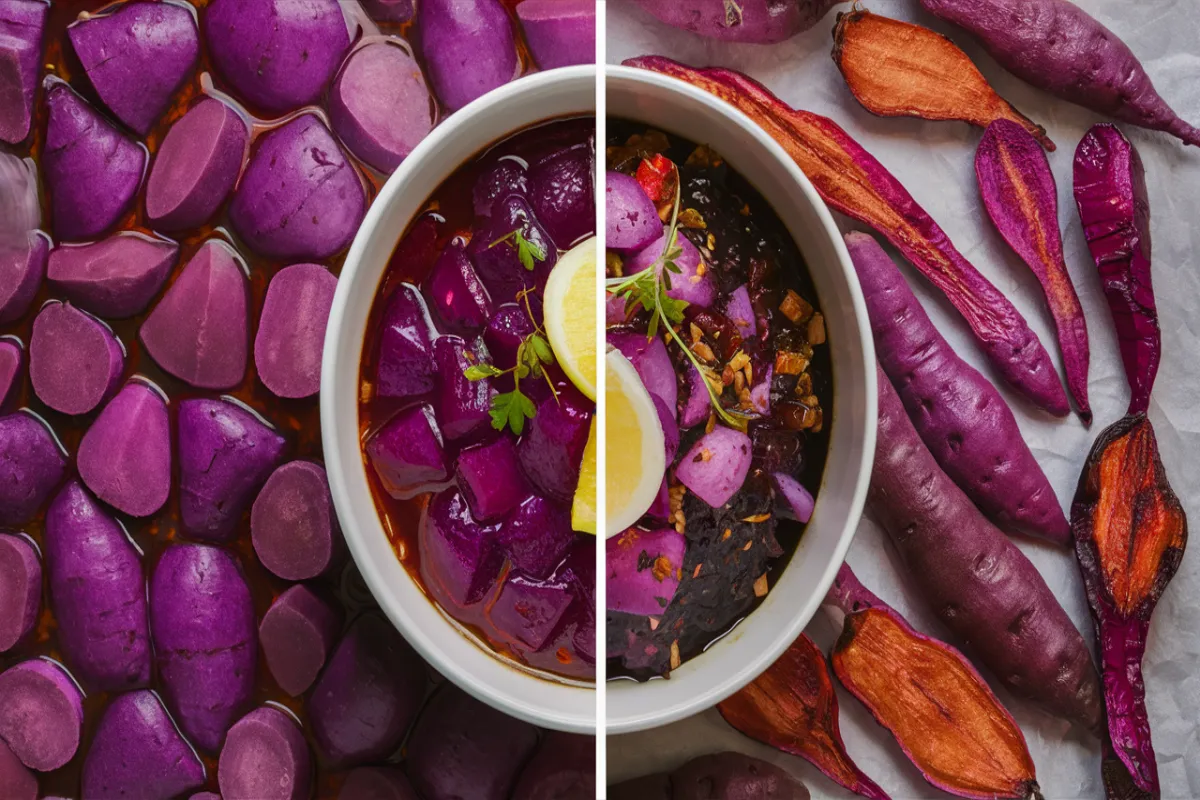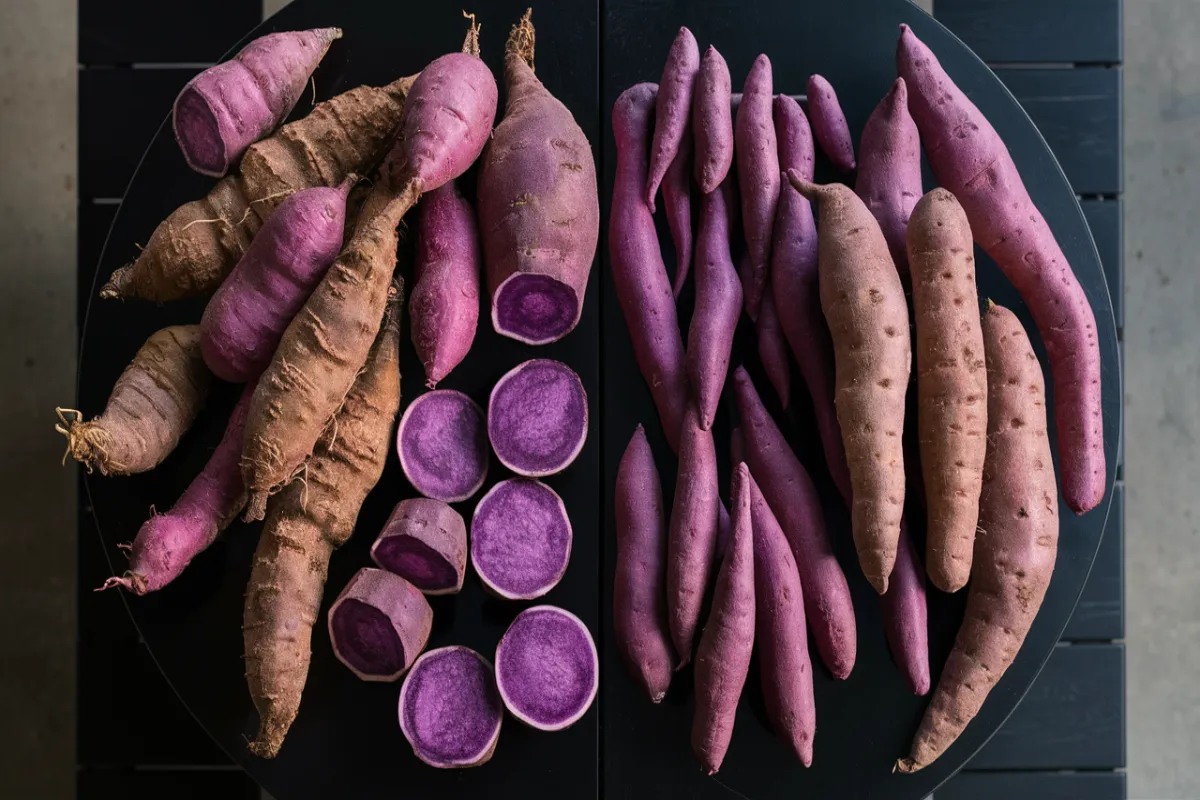When you first encounter purple yams and purple sweet potatoes, you might wonder, Is purple yam the same as purple sweet potato? Their vibrant color and similar appearance can be confusing. However, despite their shared purple hue, purple yams and purple sweet potatoes are not the same. So, is purple yam the same as purple sweet potato? The answer lies in their differences in origin, taste, texture, and culinary uses. In this comprehensive guide, I will explore the key differences between purple yams and purple sweet potatoes. By the end of this article, you will understand how to distinguish between them and use each one effectively in your cooking.
1. Understanding the Basic Differences
1.1 Origin and Botanical Classification
Purple yams and purple sweet potatoes come from different plant families. It belong to the Dioscoreaceae family, while purple sweet potatoes are part of the Convolvulaceae family. Purple yams, often known as “ube,” originate in Southeast Asia, particularly in the Philippines. On the other hand, purple sweet potatoes trace their roots to Central and South America. Understanding their origins helps clarify why these two root vegetables differ significantly in taste and texture.
1.2 Appearance and Skin Texture
At first glance, purple yams and purple sweet potatoes might look similar. However, they have distinct differences in their appearance and skin texture. Purple yams typically have rough, bark-like skin that is thicker and more rugged. In contrast, purple sweet potatoes have smoother, thinner skin that is easier to peel. These visual and tactile differences can help you identify which one you are dealing with when you encounter them in the store.
1.3 Color and Flesh Characteristics
While both vegetables feature vibrant purple flesh, the shade and intensity of the color can vary. Purple yams usually have a deep, dark purple flesh with a starchy, dense texture. Purple sweet potatoes, however, have a lighter, more violet-colored flesh that tends to be slightly softer. The color differences extend beyond aesthetics, influencing the taste and texture of the final dish. Knowing how the color correlates with these attributes can guide you in choosing the right ingredient for your recipes.
Learn how different leadership styles impact team dynamics
2. Flavor Profiles and Culinary Uses

2.1 Taste Differences Between Purple Yam and Purple Sweet Potato
Purple yams and purple sweet potatoes differ in flavor. Purple yams have a distinctly nutty, earthy flavor with a hint of sweetness. This makes them ideal for both sweet and savory dishes. Purple sweet potatoes, however, are sweeter and less earthy, with a flavor profile closer to that of regular sweet potatoes. Their sweetness makes them perfect for desserts, but they also work well in savory dishes when paired with the right ingredients.
2.2 Textural Differences in Cooking
Texture is another area where purple yams and purple sweet potatoes diverge. Purple yams have a drier, starchier texture, making them ideal for dishes where a firm consistency is desired. They hold their shape well during cooking, which is why they are often used in grated, mashed, or cubed forms. Purple sweet potatoes, however, have a smoother, creamier texture when cooked. This makes them perfect for purées, pies, and other recipes where a soft, velvety texture is preferred.
2.3 Culinary Applications
The differences in flavor and texture mean that purple yams and purple sweet potatoes have distinct culinary uses. Purple yams are popular in Southeast Asian cuisine, especially in desserts like ube halaya, a sweet yam jam. They are also used in savory dishes, where their starchy texture provides body and substance. Purple sweet potatoes, on the other hand, are versatile enough to be used in both sweet and savory dishes. They shine in recipes like roasted vegetables, pies, and even ice creams, where their natural sweetness enhances the dish.
3. How to Distinguish Between Purple Yam and Purple Sweet Potato
3.1 Identifying by Shape and Size
One of the easiest ways to distinguish between purple yams and purple sweet potatoes is by their shape and size. Purple yams are usually longer and more cylindrical, with a uniform shape. They can grow quite large and have a rough, bark-like skin. Purple sweet potatoes, however, are typically shorter, more rounded, and have a tapered shape. Their smooth skin and more compact size make them easier to handle in the kitchen.
3.2 Examining the Skin and Flesh
As mentioned earlier, the skin and flesh of these two vegetables differ in texture and color. When you cut into a purple yam, you will notice its deep, rich purple flesh and a drier texture. Purple sweet potatoes, however, reveal a lighter, more vibrant purple flesh with a slightly moist interior. These visual cues can help you quickly determine whether you have a purple yam or a purple sweet potato on hand.
3.3 Smell and Taste Tests
If you are still unsure, you can use smell and taste to differentiate between the two. Purple yams have a subtle, earthy aroma, especially when cooked. Their taste is nutty and starchy, with a slight sweetness. Purple sweet potatoes, on the other hand, have a sweeter aroma and taste. Their flavor is more pronounced, making them easy to identify once you take a bite. These sensory differences can help you confirm which vegetable you are using.
4. Nutritional Value Comparison
4.1 Nutritional Benefits of Purple Yam
Purple yams are rich in complex carbohydrates, making them an excellent energy source. They are also high in dietary fiber, which supports digestive health. In addition, purple yams contain essential vitamins and minerals like potassium, vitamin C, and B vitamins. These nutrients contribute to overall well-being and can be a valuable addition to a balanced diet.
4.2 Nutritional Benefits of Purple Sweet Potato
Purple sweet potatoes are known for their high antioxidant content, particularly anthocyanins, which give them their vibrant color. These antioxidants have been linked to various health benefits, including reduced inflammation. Purple sweet potatoes also provide a good amount of vitamin A, which supports vision and immune function. Like purple yams, they are a good source of fiber and essential nutrients, making them a nutritious choice for any meal.
4.3 Caloric and Macronutrient Comparison
When comparing calories and macronutrients, purple yams and purple sweet potatoes are relatively similar. Both are low in fat and provide a moderate amount of protein. However, purple sweet potatoes tend to have slightly more natural sugars, contributing to their sweeter taste. Purple yams, with their starchier composition, offer a denser source of carbohydrates. These differences can influence your choice depending on your dietary goals.
5. Cooking Methods for Purple Yam and Purple Sweet Potato

5.1 Best Ways to Cook Purple Yam
Purple yams are incredibly versatile and can be cooked in various ways. Boiling and steaming are common methods that help retain their nutrients while softening their dense texture. Grating and frying them into fritters or pancakes are also popular options. For a traditional touch, you can use purple yams in desserts like ube halaya, where they are boiled, mashed, and sweetened with condensed milk.
5.2 Best Ways to Cook Purple Sweet Potato
Purple sweet potatoes can be prepared using many of the same methods as regular sweet potatoes. Roasting brings out their natural sweetness and enhances their creamy texture. They can also be mashed, pureed, or used in baked goods like pies and muffins. Another great option is to slice them into rounds and bake them as chips, creating a colorful and nutritious snack.
5.3 Tips for Maximizing Flavor and Texture
To maximize the flavor and texture of both purple yams and purple sweet potatoes, consider combining cooking methods. For instance, you can boil or steam them first to soften their texture, then finish by roasting or frying to add a crispy exterior. Adding complementary spices and seasonings, such as cinnamon, nutmeg, or cumin, can enhance their natural flavors and make them the star of your dish.
6. Popular Dishes Featuring Purple Yam and Purple Sweet Potato
6.1 Traditional Dishes with Purple Yam
In Southeast Asia, purple yam is a beloved ingredient in both sweet and savory dishes. Ube halaya, a sweet purple yam jam, is a staple in Filipino cuisine. This dish is often used as a filling for pastries or served as a dessert topped with coconut milk. Purple yam is also used in savory dishes like ube puto, a steamed rice cake, where its starchy texture adds a unique twist.
6.2 Creative Recipes Using Purple Sweet Potato
Purple sweet potatoes have found their way into a variety of creative dishes around the world. They are often used in vibrant salads, where their color contrasts beautifully with greens and other vegetables. In desserts, purple sweet potatoes are used to make colorful pies, cakes, and even ice creams. Their natural sweetness makes them a perfect ingredient for both traditional and modern recipes.
6.3 Fusion Dishes Combining Both
Combining purple yam and purple sweet potato in a single dish can create a fusion of flavors and textures. For example, you could make a layered gratin using both vegetables, where the yam adds structure, and the sweet potato provides creaminess. Another idea is to create a colorful mash by blending the two together, resulting in a visually stunning side dish with a balance of earthiness and sweetness.
7. Availability and Storage Tips
7.1 Where to Find Purple Yam and Purple Sweet Potato
Purple yams and purple sweet potatoes are available in many grocery stores and farmers’ markets. However, they might be more commonly found in stores specializing in Asian or Latin American ingredients. When shopping, look for firm, unblemished roots that feel heavy for their size. Their availability might vary by season, so it’s a good idea to stock up when you find them.
7.2 How to Store Purple Yam and Purple Sweet Potato
To keep purple yams and purple sweet potatoes fresh, store them in a cool, dark place with good ventilation, such as a pantry or cellar. Avoid storing them in the refrigerator, as the cold can cause them to develop a hard core and alter their texture. Both vegetables can last for several weeks if stored properly. Check them regularly for signs of sprouting or soft spots, and use them promptly if you notice any changes in texture.
7.3 Extending Shelf Life
If you want to extend the shelf life of purple yams and purple sweet potatoes, consider freezing them. First, peel and cut them into desired shapes, then blanch them in boiling water for a few minutes. After blanching, cool them quickly in ice water, drain, and pack them in airtight containers or freezer bags. Frozen purple yams and sweet potatoes can be stored for up to six months and used directly in cooked dishes without thawing.
8. Frequently Asked Questions
8.1 Can You Substitute Purple Yam for Purple Sweet Potato?
Yes, you can substitute purple yam for purple sweet potato in most recipes, but expect some differences in texture and flavor. Purple yam is starchier and less sweet, which may alter the dish’s overall taste and mouthfeel. In recipes where sweetness is crucial, you might need to adjust the amount of sugar or other sweeteners. However, for savory dishes, this substitution works well and can add an interesting twist.
8.2 Are Purple Yams Healthier Than Purple Sweet Potatoes?
Both purple yams and purple sweet potatoes are highly nutritious, but their benefits differ slightly. Purple yams are rich in complex carbohydrates and dietary fiber, making them a good source of sustained energy. Purple sweet potatoes, however, are packed with antioxidants, particularly anthocyanins, which have various health benefits. Depending on your nutritional needs, either vegetable can be a healthy addition to your diet.
8.3 Can You Eat Purple Yam and Purple Sweet Potato Raw?
It is not recommended to eat purple yam or purple sweet potato raw, as both contain compounds that can be difficult to digest when uncooked. Cooking helps break down these compounds, making the vegetables easier to digest and enhancing their flavor. Additionally, cooking these vegetables brings out their natural sweetness and softens their texture, making them more enjoyable to eat.
8.4 How Do Purple Yams and Purple Sweet Potatoes Compare in Taste?
Purple yams have a nutty, earthy flavor with a hint of sweetness, while purple sweet potatoes are sweeter and less earthy. The taste difference is subtle but noticeable, especially in dishes that highlight the natural flavors of the vegetables. Understanding these taste differences can help you choose the right vegetable for your recipes and ensure the best flavor outcome.
8.5 Are There Other Types of Yams and Sweet Potatoes?
Yes, there are many varieties of yams and sweet potatoes, each with its own unique flavor, texture, and color. Yams come in several types, including white, yellow, and purple, each with varying levels of starchiness and sweetness. Sweet potatoes also vary, with orange, white, and purple flesh varieties available. Exploring these different types can add diversity to your cooking and introduce you to new flavors and textures.
Conclusion: Understanding the Differences Between Purple Yam and Purple Sweet Potato
Purple yam and purple sweet potato, while similar in appearance, offer distinct flavors, textures, and culinary applications. Understanding these differences allows you to choose the right ingredient for your recipes and make the most of their unique qualities. Whether you’re looking to create traditional dishes or experiment with new flavors, both purple yam and purple sweet potato can add vibrant color and taste to your meals. By learning how to identify, cook, and use these vegetables, you can enhance your culinary repertoire and enjoy the rich diversity they bring to the table.

